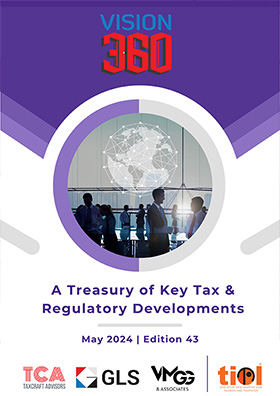Dutiable and exempted goods : Can the amount of 10 per cent paid on exempted goods be collected from the customers?
TIOL-DDT 124
30 05 2005
Monday
As is well known, a manufacturer having taken Cenvat credit, has to pay an amount equal to ten percent of the total price, while clearing exempted goods. Now the question is, can this ten percent be collected from the customer and if collected what are the consequences?
First of all it is accepted that this ten percent is not duty and so the principles applicable to duty are not applicable here. However no manufacturer would like to absorb this burden of ten percent. He would pass it on visibly or otherwise. What happens if he recovers this amount from his customers by showing it in the invoice?
There have been two types of Audit objections. In one case, the Audit contented that the rules do not permit the manufacturer to collect the ten percent from their customers and if they do, it has to be paid to the Government as required under Section 11D. In another objection, Audit believes that this ten percent has to be added to the price to arrive at the ten percent liability. And Board had, in a communication, felt that such elementary objections had to be pointed by the Central Excise field staff without waiting for wisdom from Audit!
Now take the first case:- Is Section 11D attracted? 11D speaks of any excess amount collected as representing Excise duty. This ten percent is not Excise duty and is not collected as representing Excise duty. Even if Section 11D is attracted, they have paid the ten percent to the Government, says the Tribunal in NU-WAVE SHOES v COMMISSIONER OF C. EX., NEW DELHI (2002-TIOL-192-CESTAT-DEL). The Tribunal observed that �This makes it clear that the appellants have not retained the amount collected from the customers and that they have passed on the amount to the Government as provided under Section 11D of the Central Excise Act. Hence the charge of contravention of the provisions of Section 11D is not sustainable�
So 11D is out. Then should this ten percent collected from the customer be added to the price to arrive at the ten percent? This will lead to absurd situations. Suppose the price is Rs 100 and the manufacturer collects ten percent from the customer. Now Audit would want this ten percent to be added to Rs. 100 and the amount to be paid should be Rs. 11 (10% of 110). But then if the assessee passes on this additional one Rupee also? Then the price has to be taken as 111 and 10% has to be calculated. This will go on and on till --- till infinity! No! we must stop it somewhere. Why not at the beginning? The point is, he collected Rs 110 and 10% has to be paid on that. But 110 includes 10%. It is 100 + 10. Elementary arithmetic? Not to Audit and some Commissioners!
I am not cooking up some hypothetical situations. These are real time issues and even the different benches of the Tribunal have different views on the subject. After Audit raised this objection and the department routinely, as it is the wont, confirmed the demands, the issue reached the Tribunal. As mentioned earlier, the Northern Bench of the Tribunal in the Nu-Wave case held that the 8% (then) collected is credited to the Government and so there is no violation. The Northern Bench in another decision in VIMAL MOULDERS (I) LTD (2003-TIOL-244-CESTAT-DEL), differed from the Nu Wave Shoes case, with due respect of course! Similarly the Western Bench of the Tribunal in P.T. STEEL INDUSTRIES (2003-TIOL-243-CESTAT-MUM) disagreed with the Nu wave Shoe case with due respect of course!
But in a recent case, the Bangalore Bench of the Tribunal had no such problem and it followed the NU-WAVE SHOES case. In Commissioner of Central Excise, Hyderabad-I v . Pennar Industries Limited (2005-TIOL-441-CESTAT-BANG) the Tribunal observed that,
The respondents had correctly debited 8% of the sale value of the exempted goods. This amount is not considered as duty. There is no law, which says that they should not collect this amount of 8% from the buyer of the goods. Section 11D of the CE Act, 1944 will be attracted only when duty is collected and not paid to the exchequer.
Absolutely fine and correct! There is no law against colleting this 10% from the customer. If it is not to be collected, why should any manufacturer avail the exemption at all? They can as well pay full duty and collect it from their customers! This can�t be the purpose of the exemption notification. But then what happens to the Northern Bench decision in VIMAL MOULDERS and the Western Bench decision in P.T. STEEL INDUSTRIES? Strangely they were not even mentioned before the Bangalore bench!
Now the position is, in North and Western India, you cannot collect the 10% from your customers while you can happily do so in South India! What if a company has a factory each in all these regions? And what will be the position in the Eastern Region?
Now you know why Kelkar panel recommended that CAG�s Audit should not visit factories.
Exchange rates announced for imported goods and export goods
Notification Nos 41 and 42/2005-NT-CUSTOMS, dated, May 26, 2005 fix the exchange rates for imports and exports respectively with effect from 1st April, 2005. Notifications 34 and 35/2005-Cus. (N.T.), dated 26-04-2005 are superseded.
Anti Dumping- Sodium Nitrite
The provisional anti dumping duty imposed on sodium nitrite from European Union and Taiwan is confirmed from the original date of imposition.
NOTIFICATION NO. 51/2005-Cus, Dated : May 27, 2005
DEPB Schedule amended
The DGFT has amended/added/corrected the DEPB schedule -
DGFT PUBLIC NOTICE NO. 12//2004-2009 - DATED 26 May, 2005
Until Tomorrow with more DDT
Have a Nice Day.
Mail your comments to vijaywrite@taxindiaonline.com














